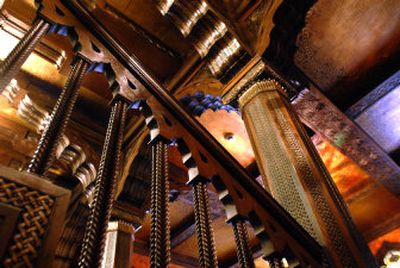Historic Patsy Clark’s restored

Patsy Clark’s Mansion, once the regal home of an early-day mining magnate and later a romantic Browne’s Addition restaurant, has won a $1.3 million property tax exemption for an extensive historic renovation.
Over the past two years, workers went through much of the ornate interior to repair woodwork, lift sagging floors and buff gouges in the hand-stamped Spanish leather that adorns many of the interior walls. An east-facing porch was restored after having been enclosed during the mansion’s use as a restaurant from 1982 to 2001.
Modernizations included an accessible ramp on the west side of the building and individual heating and cooling units throughout the mansion. The entire project cost $1.5 million.
In September, the Spokane City-County Historic Landmarks Commission approved a 10-year property tax exemption worth $1.3 million on portions of the project that qualified as historic restoration. The tax exemption is used as an incentive for preservation.
The current owners succeeded in placing the mansion on the Spokane Register of Historic Places two years ago. It was listed on the state and national historic registers in 1975-76 as part of the Browne’s Addition Historic District.
Today, the upper floors are offices for a law firm of 13 lawyers and support staff, while the finely finished lower floors are used for meetings and rental space for events such as receptions, fundraisers and outside corporate meetings.
Eymann, Allison, Fennessy, Hunter and Jones, P.S. formed a separate entity called Spokane Civic Group LLC and bought the building for $1 million in February 2003.
The firm’s total investment in the mansion now stands at about $2.5 million.
The mansion had closed as the upscale Patsy Clark’s Restaurant in May 2002 following 20 years of operation as what was likely the most popular special occasion restaurant in the city. Then-President George H.W. Bush dined there in 1989, with then-Rep. Tom Foley, who at the time was the speaker of the U.S. House of Representatives.
Attorney Richard Eymann said the bill for restoration work was “triple what we originally were told it would cost.”
Workers removed oak flooring on the sagging second-floor balcony, numbered each piece and then used steel bars to reinforce the balcony before replacing the oak boards. Two large wooden columns were added in the basement to provide support for the center portion of the mansion, which was slowly jacked back into place after having sunk more than an inch over the years. Cracks and broken tiles were repaired elsewhere in the mansion.
Eymann said it was worth the investment. “This building is almost sacred to Spokane,” he said. Some people believe it is haunted, too, by the ghost of Mary Clark, widow of Patsy Clark.
The exact date of completion is unclear from historic records – late 1897 or early 1898 – but what is still evident is the amount of time and money spent on one of the most spectacular mansions ever built in the Inland Northwest.
Clark made his fortune in mines throughout the region, and he hired renowned architect Kirtland Cutter to use nothing but the best materials in the home, including sepia-colored Italian sandstone on the exterior and rare, irreplaceable Egyptian gopher wood lining the dining room. Huge stained-glass Tiffany windows light the staircase between the first and second floors, and the landing midway up the stairs features one of the residence’s nine fireplaces, a signature of Cutter’s style.
The mix of circular turrets, columns and rounded archways reflect Romanesque and Italianate styles, but as in other Cutter works, the completed look defies easy categorization.